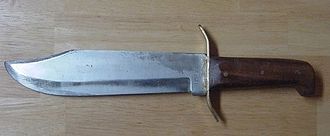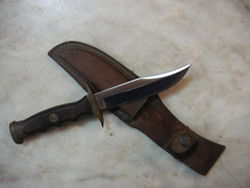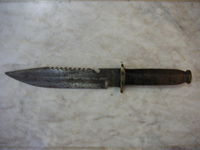From Wikipedia, the free encyclopedia
Bowie knife is a term commonly used in American English to refer to any large sheath knife. It also applies to a specific style of knife designed by Colonel James "Jim" Bowie and originally created by James Black.

A typical bowie knife, with its hallmark large blade and unique shape. This knife became popular because of its utility as a
weapon and as a tool for
camping,
fishing and
hunting.
Description
The historical Bowie was not a single design, but was a series of knives improved several times by Jim Bowie over the years.
The version most commonly known as the historical Bowie knife was rather large and of massive construction, as knives go, usually having a blade of at least six inches (15cm) in length, some reaching 12 inches (30cm) or more, with a relatively broad blade that was an inch and a half to two inches wide (4 to 5 cm) and made of steel usually between 3/16" and 1/4" thick (from 4.8 to 6.4 millimeters). The back of the blade often had a strip of soft metal (normally brass or copper) inlaid intended to catch an opponent's blade,[citation needed] a concept borrowed from the medieval Scottish dirk,[citation needed] and also often had an upper guard that bent forward at an angle, also intended to catch an opponent's blade. The back edge of the curved clip point, also called the "false edge," was often sharpened in order to allow someone trained in European techniques of saber fencing to execute the maneuver called the "back cut" or "back slash." A brass quillon was attached to protect the hand, usually cast in a mold. It is likely that the blade shape was derived from the Spanish navaja clasp knives carried in Spain and the Spanish colonies in the Americas.

miniaturized bowie knife (hunting knife).
The shape and style of blade was chosen so that the Bowie knife could serve usefully as a camp and hunting tool as well as a weapon. Many knives and daggers existed that could serve well as weapons, and many knives existed that could serve well as tools for hunters and trappers, but the Bowie knife was designed to do both jobs well, and is still popular with hunters and sportsmen even in the present day.
The curved portion of the edge, toward the point, is for removing the skin from a carcass, and the straight portion of the edge, toward the guard, is for chores involving cutting slices, similar in concept to the traditional Finnish hunting knife, the "puukko" (though the typical early 19th Century Bowie knife was far larger and heavier than the typical puukko). The blade is generally long enough and heavy enough that the knife can be used as a hatchet or machete, but not so heavy or long as to be cumbersome. Most such knives intended for hunting are only sharpened on one edge, to reduce the danger of cutting oneself while butchering and skinning the carcass.

A knife with sawteeth machined into the back side of the blade.
Since the 1960s, Bowie knives with sawteeth machined into the back side of the blade appeared inspired by the Air Force survival knife NSN: 7340-00-098-4327. The sawteeth were intended to cut through the plexiglass canopy of a downed aircraft. During the Vietnam war the US Army issued them to helicopter crews for the same purpose.
History
The Sandbar Fight
The first knife Bowie became famous with was allegedly designed by Jim Bowie's brother Rezin in Avoyelles Parish, Louisiana, and smithed by blacksmith Jesse Cleft out of an old file. Period court documents indicate that Rezin Bowie and Cleft were well acquainted with one another. Rezin's granddaughter claimed in an 1885 letter to Louisiana State University that she personally witnessed Cleft make the knife for her grandfather.
This knife became famous as the knife used by Bowie at the Sandbar Fight, which was the famous 1827 duel between Bowie and several men, including a Major Norris Wright of Alexandria, Louisiana. The fight took place on a sandbar in the Mississippi River across from Natchez, Mississippi. In this battle Bowie was stabbed, shot, and beaten half to death but managed to win the fight.
Jim Bowie's older brother John claimed that the knife at the Sandbar Fight was not Cleft's knife, but a knife specifically made for Bowie by a blacksmith named Snowden.
James Black's Bowie Knife
The most famous version of the Bowie knife was designed by Jim Bowie and presented to Arkansas blacksmith James Black in the form of a carved wooden model in December of 1830. Black produced the knife ordered by Bowie, and at the same time created another based on Bowie's original design but with a sharpened edge on the curved top edge of the blade. Black offered Bowie his choice and Bowie chose the modified version. Knives like that one, with a blade shaped like that of the Bowie knife, but with half or more of the back edge sharpened, are today called "Sheffield Bowie" knives, because this blade shape became so popular that cutlery factories in Sheffield, England were mass-producing such knives for export to the U.S. by 1850, usually with a handle made from either hardwood, stag horn, or bone, and sometimes with a guard and other fittings of sterling silver.
Bowie returned, with his knife, to Texas and was involved in a knife fight with three men who had been hired to kill him. Bowie killed the three would-be assassins with his new knife and the fame of the knife was established. Legend holds that one man was almost decapitated, the second was disemboweled, and the third had his skull split open. Bowie died at the Battle of the Alamo five years later and both he and his knife became immensely famous. The fate of the original Bowie knife is unknown; however, a knife bearing the engraving "Bowie No. 1" has been acquired by the Historic Arkansas Museum from a Texas collector and has been attributed to Black through scientific analysis.
Black soon did a booming business making and selling these knives out of his shop in Washington, Arkansas. Black continued to refine his technique and improve the quality of the knife as he went. In 1839, Black was nearly blinded by an attacker and was no longer able to continue in his trade.
Black's knives were known to be exceedingly tough, yet flexible, and his technique has not been duplicated. Black kept his technique secret and did all of his work behind a leather curtain. Many claim that Black rediscovered the secret to producing true Damascus steel.[citation needed]
In 1870 at the age of 70, Black attempted to pass on his secret to the son of the family that had cared for him in his old age, Daniel Webster Jones. But Black had been retired for many years and found that he himself had forgotten the secret. Jones would later become Governor of Arkansas.
The birthplace of the Bowie knife is now part of the Old Washington Historic State Park which has over 40 restored historical buildings and other facilities including Black's shop. The park is known as "The Colonial Williamsburg of Arkansas". The American Bladesmithing Society has also established a college at the site to teach new apprentices, journeyman, and masters in the art of bladesmithing.
Variations and collecting
Over the years many knives have been called Bowie knives and the term has almost become a generic term for any large sheath knife. During the early days of the American Civil War Confederate soldiers carried immense knives called D-Guard Bowie knives. Many of these knives could have qualified as short swords and were often made at home from old saw or scythe blades.
Variations have become popular with collectors, possibly due to the appearance of such a knife in the first Rambo film with Sylvester Stallone. Knives with the sawtooth feature are still being made and sold, often called "survival knives," and incorporating a hollow handle that can theoretically be used to carry assorted survival gear. Despite many variations, it is quipped that for a knife to be considered a Bowie knife, it must be long enough to use as a sword, sharp enough to use as a razor, wide enough to use as a paddle, and heavy enough to use as a hatchet.[citation needed]
The Bowie knife is sometimes confused with the "Arkansas toothpick". The toothpick is essentially a heavy dagger with a straight 15-25 inch blade. The toothpick is balanced and weighted for throwing and can also be used for thrusting and slashing. James Black is also credited with inventing the "Arkansas Toothpick" but no firm evidence exists for this claim.
The KA-BAR Knife of WWII fame is essentially based around the bowie design.
In recent years the Bowie style knife has sometimes been referred to as the Buck knife, for the Buck Knife Company.
A Bowie knife also appears on the shoulder sleeve insignia of the U.S. 39th Infantry Brigade, headquartered in Little Rock, Arkansas.
 Free Forum Hosting
Free Forum Hosting